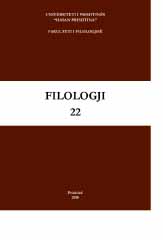ZHVILLIMI I LETËRSISË SHQIPE
THE DEVELOPMENT OF ALBANIAN LITERATURE
Author(s): Maksimilian LambercContributor(s): Naim Kryeziu (Translator)
Subject(s): Language and Literature Studies, Albanian Literature
Published by: Univeristeti i Prishtinës, Fakulteti i Filologjisë
Summary/Abstract: The oldest monument significant for Albanian language has its origin in the time of Skanderbeg (Skënderbeu), precisely in northern Albania. This is the baptismal formula, published by the archbishop of Durrës, Pal Engjëll, friend and aide of Skënderbe, in his 8th of November, 1462 pastoral letter.The oldest text in Tosk Albanian has its genesis at a later time (in southern Albania); it consists of two short linguistic records that remain printed in Greek letters in the front and back of a parchment of a Greek codex which dates back to the 14th century. The oldest authors treat mainly religious themes. Authors were priests. The earliest of them was Gjon Buzuku, born in the Northern Highlands; he published “Meshari” [The Missal] in 1555, which contains religious prayers to Saint Mary, psalms on forgiveness of sins, litanies, a catechism and the masses of the ecclesiastic year.Albanian folk songs are either lyrical or epic. Lyric songs include choral songs, mourning songs, love songs, nuptial songs dhe cradle songs. Epic songs incorporate songs of bravery, songs of warriors (Këngët Kreshnike) and legends. The songs of bravery are short rhapsodies.No other nation has dealt with its own folk poetry in such an early phase of its spiritual development and in such intensity, such love and in such a conscious act; no other people has been able to recognize its worth, has discerned it, collected it and studied it with such scholarly seriousness as the Albanian people. Folk poetry occupies a central position in Albanian spiritual life. The cult of Skënderbe takes its strength from the kindling of nationalistic feeling and love for autochthonus folklore. The hero from Mat becomes a symbol of the national unity of disperse and divided tribes and the object of passionate research. Folk literature and written literature centered on Skënderbe emerge vigoroulsy. The songs that treat the figure of Skënderbe and the continuity of his existence for Albanian people are of national significance. Albanian youth enters adulthood adoring the hero and celebrating his deeds. Albanians are open-minded; for them, research is rather easy; they are a healthy people, with a fresh mind, and they deserve appreciation with regards to their seriousness and depth at which they attempt to absorb and spread scholarly/scientific knowledge. Many scholars, especially in the field of linguistics, which is so dear to Albanian people, have already emerged and need to be taken into account for further study. Additionally, lyrical poetry is, from early on, the most congenial creative field for those eager for literary creation. And there are many who are eager for it.The determination of Albanians to learn from great nations is a sincere one. Manifold translated works from other literatures are an evidence of this. Apart from Ancient Greeks and Romans, the English, Germans and Italians are preferred. Detailed and extended treatment based on the value and type of translated literature into Albanian is an attractive task, one that must be an object of a separate study.
Journal: FILOLOGJI
- Issue Year: 2018
- Issue No: 22
- Page Range: 89 - 113
- Page Count: 25
- Language: Albanian, German

